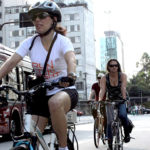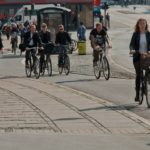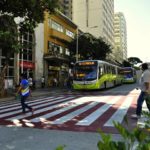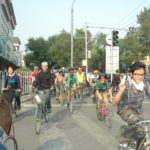Search Results
Here at TheCityFix, we love exploring the latest, most breathtaking innovations in sustainable urban development. And for good reason! Measures like São Paulo’s citizen hackathons, Medellín’s aerial cable cars, glow-in-the-dark road markings, and Hamburg and Helsinki’s plans for car-free mobility ...

The informal economy is often referred to as the “shadow economy,” a glaring indicator of its absence from the eyes of policymakers. As discussed on TheCityFix, street vendors are frequently ignored in surveys of jobs and economic productivity, despite their ...

Ljubljana, Slovenia has won the 2016 European Green Capital Award, given annually by the European Commission to cities that set an example of sustainable urban development best practices. With an ambitious sustainability plan and that has led to significant improvements in the ...

In 2004, Medellín – the second largest city in Colombia – introduced the Medellín Metrocable system to connect low-income residents to public transport. As the world’s first modern urban aerial cable car transport system, this innovative addition to Medellín’s existing ...

The city of São Paulo has won the 2014 Enterprising City/State MobiPrize following its support of user information and public participation platforms to advance sustainable transport solutions. MobiPrize was launched in 2012 by the University of Michigan SMART (Sustainable Mobility ...

Instead of sitting in gridlock on a busy road at 8:30 am, imagine cycling safely in dedicated lanes for a quick, pleasant commute. Many cities around the world are making investments that will give residents a faster, safer cycling experience ...

China’s increasing overall wealth makes it unlikely that the country’s growth in car ownership will stop any time soon. However, severe air pollution and traffic congestion have led several large Chinese cities to take action to stem the rising tide ...

Congestion, high levels of air pollution, and traffic crashes are consequences of a culture of investment that has focused for decades on the automobile. These externalities can cost up to 10 percent of a country’s GDP, and the world’s vehicle fleet is ...

Erik Vergel-Tovar, no stranger to TheCityFix, is a PhD candidate in the Department of City and Regional Planning at the University of North Carolina at Chapel Hill, where he researches the rich relationship between bus rapid transit (BRT) – a ...

Madeline Brozen is a Program Manager within UCLA’s Complete Streets Initiative and a recipient of the 2014 Lee Schipper Memorial Scholarship. Her research focuses on urban design policy, with an emphasis on how cities can shift from car-oriented streets to ...

Each year, 440,000 people move to Beijing in search of economic opportunity and better lives. Their rural to urban migration is a driver of economic growth, part of a larger plan to catalyze economic development through urbanization across China. However, ...

Sustainable urban mobility can come from multiple sources. Personal rapid transit (PRT) combines public transport with personalized routing. Though their designs vary, PRT systems generally consist of four- to six-passenger pods that are autonomously controlled while traveling along guide-ways. Instead ...

As previously discussed on TheCityFix, informal street vendors in cities around the world experience daily challenges to their economic livelihoods. For example, street vendors are perceived to be detrimental to city life, unhygienic, noisy, and to obstruct smooth flow of ...

The “People-oriented Cities” series – exclusive to TheCityFix and Insights – explores how cities can become more sustainable and livable through transit-oriented development (TOD). The nine-part series addresses different urban design techniques and trends that reorient cities around people rather ...

The Economist recently argued that streetcars are “a waste of money,” citing their high capital costs and inefficiencies as a means of transport. Others have argued that streetcars can be a catalyst for creating dynamic, vibrant urban environments. Both arguments ...

Page 87 of 227« First...1020...868788...90100...Last »


























